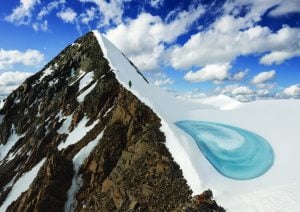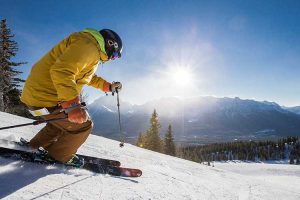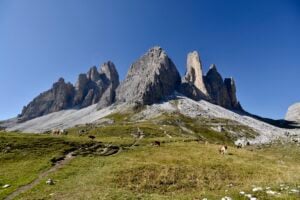
Environment
Why mountains matter in Canada
They sustain us, enrich our lives and inspire us
- 1287 words
- 6 minutes
Travel
A Canadian ski-touring legend reminisces about snow-bound cultural connections made prior to the COVID-19 pandemic and mounting political tensions

After ski-touring 840 metres up to a ridge on the Chinese side of the Altai Mountains, ski guide Laura Adams pauses to survey her surroundings. An endless sea of craggy snow-covered peaks beneath a cobalt-blue sky spans her full field of vision. To her immediate right, a stand of alpine larch trees stand January-bare and motionless — not even the reediest bough sways in the still air. Whitney Thurlow, Adams’ friend and colleague, skies up beside her.
“Amazing,” says Thurlow. Adams knows he means more than the view. In their collective seven decades of ski-touring guiding, neither has seen so much snow with so little wind effect. Every slope, in every direction, is smooth and silent; blanketed by at least a metre of untouched powder. Adams can’t stop grinning; carving turns on the descent is going to be sublime.
Adams can’t stop grinning; carving turns
on the descent is going to be sublime.
The Altai (also spelled Altay), meaning “golden,” mountains occupy a particularly remote region at the intersection of Kazakhstan, China, Russia and Mongolia. Collectively known as South Central Siberia, the area is Eurasia’s point of inaccessibility — the place on the continent farthest from any ocean, and thus the most difficult to access. After flying from Vancouver to Beijing, Adams took two more flights to reach China’s northwestern-most tip: the Altay Prefecture within the Xinjiang Uygur Autonomous Region. There, in Altay City, she hired a man — who showed up with a goat in the back of his pickup truck — to drive her five hours out of the plains and over an obscure mountain pass to Hemu, the hamlet that would serve as Adams’ Altai Mountain basecamp. Prior to the prefecture starting to plow the pass a couple years ago, Hemu was sealed off from the rest of the world during the winter. Adams made the long journey because China’s Altai Mountains are now widely believed to be the birthplace of skiing — the sport around which she’s built her life.
Adams, 52, is one of the world’s top ski-guide explorers. A Fellow with The Canadian Royal Geographical Society, she holds dual Canadian and New Zealand citizenships. She was among the first ski-tour guides, in 2011, to start running off-piste trips in Japan, in the true backcountry, not just the side country of the resorts. In 2018, she guided the first exploratory heli-skiing trip in Baffin Island, Nunavut, earning a place on Men’s Journal’s 2019 list of “World’s Most Adventurous Women.” She followed it up with a ski-touring expedition into some of Baffin’s most remote glaciers. In the off season, Adams works with a team of scientists, naturalists, culturalists and educators to run trips through the Canadian Arctic Archipelago.
Skiing in China came on her radar shortly after the country hosted the first-ever International Ski History Conference in 2015 to present findings that rock paintings and carvings found in the Altai Mountains showing people hunting on skis were more than 10,000 years old. “I was fascinated, and intrigued,” says Adams, who had, up until that point, understood Scandinavia to be the birthplace of skiing. A subsequent study, published in 2016 in Rock Art Research: The Journal of the Australian Rock Art Research Association (AURA), was more conservative, concluding the Chinese rock art was made between 4,000 and 5,250 years ago. Still, the estimate makes the Altai findings just as old, if not older, then the skiing rock art and artifacts found in Scandinavia. And possibly older than the earliest artifact currently recognized by the International Ski Federation — a remnant of a wooden ski found near Lake Sindor in Russia that’s been dated between 5,000 and 6,300 years old.
The clincher for Adams was when Thurlow told her he’d learned that there were villages in China’s Altai Mountains where locals still got around in the winter by khok, wooden skis covered in horsehair, just as they had been doing for thousands of years. “It’s an ancient mountain culture that still exists today,” says Adams. “That’s so incredibly rare.” Within a year, she and Thurlow were planning a ski-touring trip to Hemu with a small, hand-picked group of backcountry skiers from Canada and New Zealand. They would be among the first Westerners to visit.
‘It’s an ancient mountain culture that
still exists today. That’s so incredibly rare.’
Laura Adams stands outside the guesthouse in Hemu, known simply as Mr. Wang’s place, a series of wooden cabins built in the local tradition of using stacked logs for walls. The brisk -20 C air smells faintly of charcoal from breakfast, when rice and vegetables were cooked outside over hot coals next to the dining cabin. Across the bridge spanning the frozen Hemu river, a team of horses towing chanas, wooden sleds, waits to carry Adams and her group out of the valley floor and into the foothills to start their ski tour.
While Adams waits for her ski-touring companions to gather, a middle-aged man carrying a pair of traditional horsehair skis approaches. Adams admires his attire. He is clearly a local, dressed in a full-length horsehide jacket with wolf hair lining the hood and sleeves. Adams wonders how her mulberry toque, neon yellow jacket and burnt orange snow pants appear to him. She makes eye contact and smiles. The man smiles back. Adams watches him stick his skis in the snow next to her modern powder skis, then pantomime a request to touch her skis. Adams nods enthusiastically. He lifts them and makes an exclamation she can’t understand, but most certainly means, ‘Whoa, these are light!’

The man’s traditional skis are carved from pine and not quite as wide as hers, but probably twice as heavy. Adams studies the leather toe-straps and laces that affix the skis to his boots. Horsehide with the hair still attached covers the bottom of each ski. Unlike Adams’ skis, which have removable synthetic “skins” for traction on the uphill, the horse hair is a permanent part of traditional skis. Grippy enough to catch on the uphill, but smooth enough to glide on the downhill. Adams takes off a glove to stroke the thick hair, a luminous shade of chestnut. “Shia shia, thank you,” she says to the man.
Adams grew up in the Selkirk Mountains, a subrange of the Columbia Mountains, in the British Columbia interior. Her parents were alpinists who immigrated to Canada from England in the 1960s to tackle first ascents in the then-unknown peaks of B.C. They put Adams on skis at age two. Her earliest childhood memories include waking beneath a red pop-up tent in Kokanee Glacier Provincial Park. Adams started guiding professionally at age 18, and in 1997 became only the fifth woman to be certified by the Association of Canadian Mountain Guides in ski guiding. She would go on to pursue her master’s degree in leadership and learning; her research on high-risk decision making in mountain environments earning an award from the Social Sciences and Humanities Council of Canada. For Adams, the mountains, no matter how far-flung, will always feel like home.
She attributes her recent fascination with the people who live in traditional mountain cultures to time spent in the Arctic collaborating with Inuit. Over the past few years, on expeditions in Greenland and the Canadian Arctic, Adams has been repeatedly delighted by the wisdom of local outfitters and guides; finding their “ancient knowledge” about weather and terrain far beyond what she was able to glean using so-called modern tools and techniques. But perhaps more so, Adams is experiencing a value shift as she enters her third decade of guiding. “When I look back on my career so far, it’s not the things that I did or the places I went,” she says, “it’s the people that I remember.” For Adams, the human experience — the connection she makes with the people she guides and the people living in the communities where she skis — has come to mean the most.
Ironically, the human element is also what can make embedding in places like Hemu so challenging. For Adams, the struggle wasn’t reaching Eurasia’s point of inaccessibility, it was travelling to China during a period of rapidly escalating political tension. In December 2018, the month before she was set to travel, Canada arrested Huawei executive Meng Wanzhou in Vancouver. Ten days later, in apparent retaliation, China detained two Canadian men on suspicion of espionage. The Canadian Association of Mountain Guides advised Adams not to visit China. “I was told that if anything were to happen we wouldn’t be provided with any support,” says Adams. “None of my [ski guiding] insurance, for example, would be valid.”
Two days after Adams arrived in China, the country sentenced a Canadian citizen to death for allegedly attempting to smuggle methamphetamine. Canada increased its travel advisory to China to “Exercise a high degree of caution.” For Adams, the tension in-country was palpable.
“We were the subject of a lot of interest and watched very closely during our whole period of time there,” she says. Each of the half-dozen times Adams and her group were stopped at a security checkpoint during the long drive from Altay City to Hemu, Adams feared they’d be unjustly detained. Once in Hemu, the first place she visited was the local police station for what she was told was a routine check in. She and the others sat along a wooden bench in a cigarette smoke-filled lobby as officials interrogated their three drivers and junior guide Chen — a young man who grew up in China but was now living in New Zealand.
“All I could do at that point was hope that the experience we would have on the broader trip overall would outweigh the risks,” says Adams.

‘It’s not the things that I did or the places
I went, it’s the people that I remember.’
After two hours of skinning — using synthetic skins to trek uphill on skis — through an aspen and pine forest along the Hemu River, Adams and her group arrive at a modest homestead and ranch at the base of the foothills. But the traditional ski maker she’d hoped to visit is not there. His son, a man in his early 40s, apologizes. His father is dying, he tells Adams through Chen’s translation, they’d had to take him to the hospital. Would they still like to come inside? Adams welcomes the invitation. Yes, please, she nods.
The ski-maker’s son unlocks a door to a one-story structure with the now-familiar stacked-log walls and ushers them through what appears to be a museum showcasing his family’s ethnic history. They are Tuvans, a traditionally nomadic people that crossed into China from Mongolia as early as the days of Genghis Khan. The family lives in Hemu much the way Tuvans always have, herding animals and hunting. Many of their tools are on display in the museum: a cow, or perhaps horse, bladder used to hold water; a bow and arrow set carved from pine; a pair of horsehair skis worn to retrieve lost or stranded animals in the deep snow, and to track elk through the rolling foothills. Adams is reminded of the fact that the world’s first skis weren’t recreational, they were utilitarian.

In a second room, a twin-sized bed made up as a couch with embroidered throw pillows is pushed up against the back wall. A long, low table draped in a cloth of golden flowers sits in front of it. The ski-maker’s son motions for Adams and her group to sit. His wife brings in stools so they can fit around the table. The couple then moves quickly in and out of the adjacent kitchen to fill the table with snacks: a platter of walnuts, golden raisins and cubes of cheese made from milk from the family’s two cows; a bowl of bread and rolls; a plate of crackers and cookies; and a dish of hard candy wrapped in brightly coloured cellophane. The ski-maker’s son pours glasses of milk tea as his Kindergarten-aged son stands behind his mother’s legs and peers shyly at Adams. It occurs to her that the boy, the ski maker’s grandson, has probably never seen someone with blonde hair and green eyes before. She greets him, hoping to draw him out, but he scampers back into the kitchen.
When it is time to go, the ski-maker’s son shows them out through the kitchen, where Adams finds the boy sitting at the table playing a game on a board made of wood and leather. The boy looks up and watches as her ski-touring companions walk by. Adams lags behind and waits until the others are outside. Then she approaches the boy, crouching down so they are at eye level. He ducks his head but she can see he is smiling. She reaches into her backpack and pulls out a medallion of an orca, a token she’d packed exactly for such occasions. Adams calls Chen back in. She asks him to explain that the creature is a whale made by a Haida artist, a man whose ancestors had been living in a remote section of Canada — on an island off the northwest coast — for more than 12,500 years. The boy listens, his eyes locked on the orca in Adam’s outstretched palm. When Chen finishes, the boy looks up at Adams. She sees his eyes are green too. She beams. He giggles and reaches for the gift.
No matter her discomfort in travelling to China during a time of political tension, she will never forget her exchange with the ski maker’s grandson.
Are you passionate about Canadian geography?
You can support Canadian Geographic in 3 ways:

Environment
They sustain us, enrich our lives and inspire us

Travel
Leslie Anthony shares the best of the big hills

Environment
A new report by Alpine Club of Canada scientists and other experts highlights worrying trends in Canada’s mountain ecosystems

Travel
Once an enormous coral reef, these magnificent mountains are now one of Italy’s main outdoor attractions